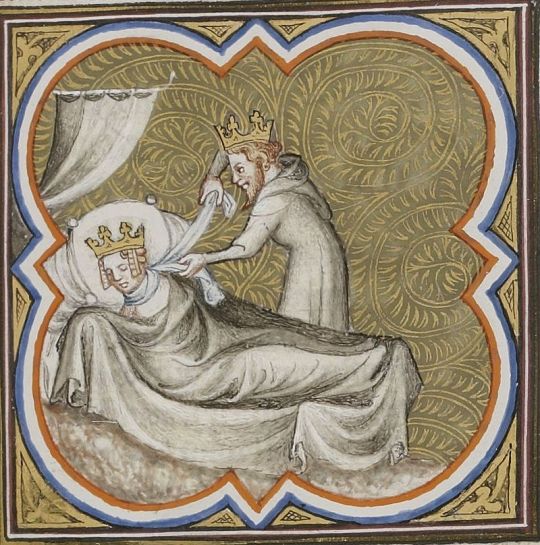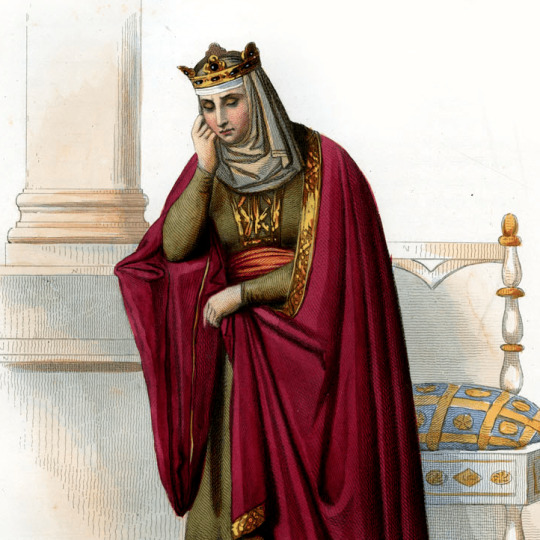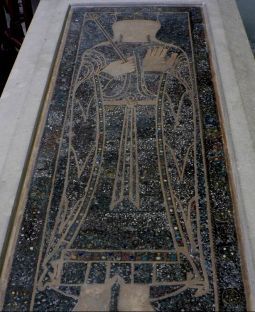#the death of galswintha
Explore tagged Tumblr posts
Text

The Death of Galswintha (1846) | Eugène Philastre
#art#fine art#painting#aesthetic#oil painting#dark#19th century#the death of galswintha#eugène philastre
13 notes
·
View notes
Text

The Death of Galswintha
Brunhild’s elder sister, Galswintha, arrived in Frankish lands as Chilperic I of Neustria’s betrothed in July of 568, trailed by even more treasure and finery than her sister had been. At Rouen, Chilperic tripped over himself to provide an even more spectacular reception than his brother had given Brunhild. He marched his army more than one hundred miles west, so they might meet his new bride ‘near the curved bed’ of the river Seine as she disembarked from her ship. Rather than being greeted by a palace hall full of nobles, Galswintha was welcomed by Chilperic’s entire army on bended knee, swearing an oath of allegiance to their new queen. Chilperic never did anything in half measure. And Galswintha was married not in the great hall of a converted basilica, but in the cathedral at Rouen.
Less than six months later, though, a third wedding would take place. No cathedral this time, just a handful of nobles quickly assembled in the great room of a royal villa. A week before this third wedding, King Chilperic and Queen Galswintha had been fighting. As she stormed and raged, messengers were seen riding out from the palace at all hours, delivering missives and pleas to her sister and her mother. Galswintha had caught Chilperic in bed, again, with the slave girl Fredegund. The queen was furious that ‘he showed no respect to her at all’; she was distraught over ‘the insults which she had to endure’. She wanted to return home. Was it truly so unendurable? Yes, to be made a fool of like that. And Chilperic had such a temper! She would return home, even if it meant leaving her enormous dowry behind. One morning, soon thereafter, the palace woke to a horrible scene. Galswintha had been found dead in her bed, strangled in her sleep.

Chilperic did not once address his subjects on the matter of Galswintha’s untimely demise. There were no searches for her assailants or rewards offered for their capture. No one was ever questioned or punished, not even the guards who had been posted at the door of the royal bedchamber that night. It was Fortunatus’s friend Gregory who stated plainly what the whole of France was thinking: ‘Chilperic ordered Galswintha to be strangled… and found her dead on the bed.’
Just months after Galswintha’s wedding, Brunhild had received word that her father had dropped dead, presumably of a heart attack. When the next message arrived, this one from Galswintha’s terrified nursemaid, it was reported that Brunhild went into shock. In less than eighteen months, Brunhild had lost her homeland, her father and now her only sibling. At the news of Galswintha’s death, Spain falls into even greater lamentations, and her grieving mother ‘collapses in distress, her knees giving way’ and faints. The enraged mother of the murdered princess was still a major player in international politics; after the death of King Athanagild, she had married his successor.

The few tears Chilperic reportedly shed shortly after Galswintha’s murder may have even been genuine: he was sad that things had come to this. It was nothing personal; Galswintha was simply no longer useful to him. But Fredegund was. Chilperic was obviously incredibly attracted to her. And his attraction also solved several problems. A low-born woman came without the complications of a powerful family; she would be happy with whatever meagre morgengabe he gave her. Three days later, arrayed in the brightly dyed linens and jewels of her predecessor, Fredegund stood at the altar, smiling up at Chilperic.

Galswintha’s murder has been portrayed in art numerous times throughout the centuries since, and the blame always rests on Chilperic, so much so that illuminated manuscripts and paintings portray the king of Neustria himself, wearing his crown and grinning rakishly, wrapping a cloth around the neck of his sleeping wife. In some versions, Fredegund looks on. Whether Fredegund really urged him on or not, she knew people would always assume that she had, cleverly disposing of yet another rival for the king’s affections.
Source:
Shelley Puhak, The Dark Queens: A gripping tale of power, ambition and murderous rivalry in early medieval
#galswintha#chilperic#fredegund#brunhild#brunequilda#brunhilda#brunegilda#french history#merovingians#neustria
14 notes
·
View notes
Text
OCtober 2024 Day 14: Who or What Inspired Your OC
I promised my friends an interesting context to an important myth in the Fate fandom, so here we are.
Curtis is based a little bit on a historical figure named Galen. Not Aelius Galenus, but an obscure figure connected to figures that would later inspire parts of Nibelungenlied.
Content Warning: there is an event within this series of events that can be read as an incestuous marriage between non-blood related relatives. There’s also a lot of violence, murder, and an event that can be seen as self harm. These are historical events, please be thoughtful with how you engage with them.
A lot of what survives from this situation comes from Gregory of Tours. Look, I read a decent amount of Decem Libri Historiarum for this, which I wouldn’t recommend for researching OCs.
In the 500s, the Franks were in a civil war after Chlothar I died and split his kingdom between his four sons. Two of them, Chilperic I and Sigebert I, immediately went to war with each other. In the middle of this civil war, Sigebert marries Brunhilda of Austrasia.
This causes much drama amongst the brothers given Brunhilda’s status as an educated woman, which is atypical for the brothers’ spouses. Chilperic claims to want to marry Brunhilda’s sister, Galswintha, possibly out of jealousy. This relationship is short lived, however, as Galswintha is murdered by Chilperic and his favourite mistress, Fredegund.
You should start to notice some familiar names. Features of Fredegund and Brunhilda are both considered inspirations for Brunhild and Kriemhild. Sigebert probably inspired Sigurd. But where does Galen fit in? Let me get to that.
Sigebert tries to avenge Galswintha, but gets murdered by assassins from Fredegund. Brunhilda is still alive, which will become important later.
Meanwhile, Chilperic naturally has some kids across his various marriages. One of the kids from his first wife, Audovera, had a son named Merovech. What happened to Audovera? Don’t worry, Fredegund had her murdered too.
Merovech has enough sense to realize this situation is terrible for everyone involved. This is where Galen shows up as well. Galen is mentioned as Merovech’s servant, but you can kinda read him as Merovech’s accomplice in what’s about to go down. There’s also a bit of a “Historians think they were roommates” energy.
For example, there’s one incident Gregory of Tours talks about where Chilperic realizes that Merovech poses an actual threat, so he has the prince shipped off to a monastery. Galen breaks in and smuggles him out.
Merovech realizes the only way he will amass enough power to overthrow his dad is to marry into it, so he contacts the woman who hates his father the most— Brunhilda. This marriage is incredibly scandalous and done in secret by the bishop Prætextatus. Due to his involvement with this marriage, Prætextatus was exiled briefly and later assassinated allegedly under Fredegund’s orders.
In the aftermath we have the “shipped to a monastery” event, which was an attempt to nullify the marriage. Merovech gets out with Galen’s help and the two live on the run for several years while trying to overthrow Chilperic. They’re eventually sieged in a town and, realizing there was no escape, Merovech asked Galen to kill him. Galen was captured in the aftermath and was tortured to death by Fredegund.
To tie up the loose ends, Chilperic was eventually eventually assassinated on a hunting trip, Fredegund shockingly dies of natural causes, and Brunhilda was executed by Fredegund’s son, Chlothar II.
This is a very streamlined retelling of these events and if you’re curious about this clusterfuck, I encouraged you to do some deeper reading. Gregory of Tours is a sarcastic, bitter menace about this situation. Just look at this piece of art at the end of this post, reflecting the relationship between him and Chilperic!
As a final note, Gregory felt that Prince Merovech was morally correct to attempt a rebellion against Chilperic, but his youth and inexperience in an already fraught situation meant there was no way Merovech could have succeeded.
As for how this inspired Curtis, my partner’s OC is inspired in part on King Merovech. Merov is the dragon and Curtis is the dragon slayer, you see. But I kept bumping into Prince Merovech while doing research and his grim fate with Galen felt like a tragic past lifetime where the dragon and the dragon slayer teamed up to try to save the world and failed against impossible odds.

#bweirdoctober#storytime with Teddog#TTRPG#thoughts about writing#thoughts about gaming#Merovingian dynasty#Maybe later I’ll rant about Merovingian vampires#Type Moon really needs to talk more about the Merovingians although I love their take on the Carolingians
4 notes
·
View notes
Text

Brunhilda (c. 543 – 613) was queen consort of Austrasia, part of Francia, by marriage to the Merovingian king Sigebert I of Austrasia, and regent for her son, grandson and great-grandson.
In her long and complicated career she ruled the eastern Frankish kingdoms of Austrasia and Burgundy for three periods as regent for her son Childebert II from 575 until 583; her grandsons Theudebert II and Theuderic II from 595 until 599; and her great-grandson Sigebert II in 613. The period was marked by tension between the royal house and the powerful nobles vying for power.
Brunhilda was apparently an efficient ruler, but this and her forceful personality brought her into conflict with her nobles, the church and the other Merovingians. Her bitter feud with Fredegund, mistress of Chilperic I of Neustria, who murdered Brunhilda's sister, Queen Galswintha (c. 568), in order to replace her as queen, lasted until Fredegund's death in 597. Fredegund had Brunhilda's husband murdered and Brunhilda imprisoned for a period. This feud was continued by Fredegund's son, Chlothar II, who in 613 defeated Brunhilda in battle and had her executed by being pulled apart by four horses.
3 notes
·
View notes
Video
youtube
Queen Galswintha: The Murdered Queen of the Franks #Queen Galswintha #Me...
Queen Galswintha was a Visigothic princess who married King Chilperic I of the Franks in the 6th century. Her tragic death, allegedly at the hands of her husband’s mistress, ignited a series of violent political events known as the Frankish civil wars.
0 notes
Text
Brunhilde was a visigothic princess of untold wealth and good blood from what is now Spain. She was sent north to the barbaric Franks to marry Sigfurd of Austrasia. Your marriage is going actually really well.
But then your insufferable brother in law Chilperic King of Neustria sends for another of your sisters, Galswintha. Literally no one wants this marriage to happen.
Least of all Chilperic's long time mistress Fregegund. Your sister is about to run back to your father with her dowry but uh oh she was strangled to death in her bed. It was so obviously Fregegund and Chilperic. As they get married three days after your sister's murder.
So you plot for your whole life to take this bitch and her husband down. You husband is pretty cool about these whole plots he wants his brother's portion of Francia anyway.
Literally nothing you could do to Fregegund could be unjustified she tried to kill her own daughter by slamming her head in a chest repeatedly.
Unfortunately, Fregegund's son does get the last laugh as he has you drug behind a horse through the city, and all your body parts fall off before promptly uniting all the lands his father and uncles couldn't... oh well
How in the world is Brunhilde and Fregegund rivalry not made into a comedy show of The Real Housewives of Francia
4 notes
·
View notes
Photo

Eugène Philastre, The Death of Galswintha, 1846
8 notes
·
View notes
Photo

The Tragedy of an Honest Wife: Galswintha on Her Death Bed, Lawrence Alma-Tadema, 1875, Harvard Art Museums: Drawings
Harvard Art Museums/Fogg Museum, Gift of Samuel D. Warren Size: 65.5 x 47.7 cm (25 13/16 x 18 3/4 in.) Medium: Watercolor on off-white wove paper (laid down to rectangular sheet)
https://www.harvardartmuseums.org/collections/object/296910
8 notes
·
View notes
Photo








(Anonymous, Strangling of Galswintha by Chilperic, c. 1375/1380)
(Eugène Philastre, Murder of Queen Galswintha, 1846)
(Jean-Paul Laurens, The Death of Galswintha)
(Louis-Charles-Auguste Couder, Chilperic I and strangled Galswintha)
Galswintha, the elder of the two daughters of Athanagild, King of the Visigoths, married Chilperic I of Neustria sometime between 566 and 567. Chilperic was initially delighted with her — perhaps because of her large dowry — but eventually tired of her and began to sleep again with this concubine, Fredegund.
Galswintha was found strangled in her bed in 568 and it was suspected that either Chilperic or Fredegund had ordered it. Galswintha’s sister, Brunhilda, who was married to Chilperic’s half-brother, Sigebert I of Austrasia, was enraged at her sister's murder and had her husband declare war on Chilperic. The feud between Neustria and Austrasia would eventually claim the lives of both Sigebert and Chilperic.
#merovingians#galswintha#medieval#eugene philastre#jean paul larens#louis charles auguste couder#art#art history#history painting
38 notes
·
View notes
Text

Brunhild, also spelled Brunhilda, Brunhilde, or Brunechildis, French Brunehaut, (born c. 534—died 613, Renève, Burgundy [now in France]), queen of the Frankish kingdom of Austrasia, daughter of the Visigothicking Athanagild, and one of the most forceful figures of the Merovingian age
In 567 Brunhild married Sigebert I, king of Austrasia, changing her religion from Arianism to Roman Catholicism. In the same year, her sister Galswintha married Sigebert’s half brother Chilperic I, king of the western part of the Frankish territory, but in 567 or 568, at the instigation of his concubine Fredegund, Chilperic had Galswintha murdered. Prompted by Brunhild, Sigebert then exacted Galswintha’s marriage settlement (Bordeaux, Limoges, Quercy, Béarn, and Bigorre) as retribution from Chilperic. When Chilperic tried to recover this territory, war broke out between him and Sigebert (573). At first it ran in Sigebert’s favour, but in 575 he was assassinated and Brunhild was imprisoned at Rouen. There, however, Merovech, one of Chilperic’s sons, went through a form of marriage with her (576). Chilperic soon had this union dissolved, but Brunhild was allowed to go to Metz in Austrasia, where her young son Childebert II had been proclaimed king. There she was to assert herself against the Austrasian magnates for the next 30 years. She encouraged the Byzantine-backed pretender Gundoald against Guntram, king of Burgundy, but Guntram made Childebert his heir, placating Brunhild and securing his own position against Gundoald.
After Childebert’s death (595), Brunhild failed to set herself up as guardian over Childebert’s elder son, Theodebert II of Austrasia, and thus stirred up against him his brother Theodoric II, who had succeeded to Burgundy. Theodebert was overthrown in 612, but Theodoric died soon afterward (613), whereupon Brunhild tried to make the latter’s eldest son, the 12-year-old Sigebert II, king of Austrasia. The Austrasian magnates appealed to Chlotar II of Neustria against her. Brunhild tried in vain to enlist the help of the tribes east of the Rhine and then fled to Burgundy. Garnier, the mayor of the palace in Burgundy, was in league with Chlotar, however, and Brunhild’s army refused to fight when it met Chlotar’s on the Aisne River. Brunhild was handed over to Chlotar at Renève (northeast of Dijon). The nearly 80-year-old queen was tortured for three days, bound to a camel and exposed to the mockery of the army, and finally dragged to death at a horse’s tail (autumn 613).
Brunhild’s ashes were interred in a mausoleum erected near the abbey of St. Martin at Autun, which she had founded. Her memory was highly venerated there, but historians throughout the ages have had conflicting opinions about her. Gregory of Tours applauds her for her personal morality and for her political wisdom, whereas Fredegarius treats her with undisguised vitriol. The Franks over whom she sought to rule resented her Gothic origin, and the tragic course of her life has made her a figure of legend.
#historical#historical figures#history#brunhilde#brunhilda#brunhild#chilperic#franks#merovingian#chlotar#guntram#sigebert#austrasia#middle ages#nur fettahoğlu#fancast
62 notes
·
View notes
Photo






MEROVINGIAN REGINAE | Fredegund Regina († 597)
Third principal wife of Chilperich I Rex, to whom she bore five sons, Chlodobert Rex, Samson Rex, Dagobert Rex, Theodorich Rex and Chlothacar II Rex, and one daughter, Rigund Regina. As Chilperich’s wife, she may have lived between several civitates, such as Rotomagus (Rouen), Parisius ( Paris), Sexonas (Soissons) or Brennacum (Berny).
According to Gregorius of Tours, she was already his favourite even before the wedding with Galswintha Regina in 567, and despite the fact he had to put aside his whole women and concubines for this wedding, including his first chief wife, Audovera Regina, he quickly took her back near him. Even if we do not know exactly when or why, it must have been because she bore him her first son Chlodobert Rex, much to the anger of Galswintha Regina, who felt outraged by her presence.
“[...] promittens per legatus se alias relicturum, tantum condignam sibi regisque prolem mereretur accipere. [...] Quae cum ad Chilpericum regem venisset, cum grande honore suscepta eiusque est sociata coniugio; a quo etiam magno amore diligebatur. Detulerat enim secum magnos thesauros. Sed per amorem Fredegundis, quam prius habuerat, ortum est inter eos grande scandalum.
He told the messengers to say that he promised to dismiss all the others, if only he were considered worthy of marrying a King’s daughter of a rank equal to his own. [...] When she reached the court of King Chilperic, he welcomed her with great honour and made her his wife. He loved her very dearly, for she had brought a large dowry with her. A great quarrel soon ensued between the two of them, however, because he also loved Fredegund, whom he had married before he married Galswinth.”
DLH, IV 28. De uxoribus Chilperici
After the death of Galswintha Regina in 568, she officially became Chilperich’s new chief wife and gave birth to all of his other children. Basing on the sources, he apparently remained faithful to her and did not take other significant concubine. Fredegund seemed to have been very popular and loved by the people, and was also known as being a good administrator and landowner, as she was able to raise money and numerous gifts for her daughter’s dowry.
“Sed et mater eius inmensum pondus auri argentique sive vestimentorum protulit, ita ut videns haec rex nihil sibi remansisse potaret. Quem cernens regina commotum, conversa ad Francus, ita ait: ‘Ne potitis, viri, quicquam hic de thesauris anteriorum regum habere; omnia enim quae cernetis de mea proprietate oblata sunt, quia mihi gloriosissimus rex multa largitus est, et ego nonnulla de proprio congregavi labore et de domibus mihi concessis tam de fructibus quam tributis plurima reparavi. Sed et vos plerumque me muneribus vestris ditastis, de quibus sunt ista quae nunc coram videtis; nam hic de thesauris publicis nihil habetur’.
Her. mother added a vast weight of gold and silver, and many fine clothes. When he saw this, King Chilperic thought that he had nothing left at all. Queen Fredegund realized that he was upset. She turned to the Franks and said: ‘Do not imagine, men, that any of this comes from the treasures amassed by your earlier kings. Everything you see belongs to me. Your most illustrious King has been very generous to me, and I have put aside quite a bit from my own resources, from the manors granted to me, and from revenues and taxes. You, too, have often given me gifts. From such sources come all the treasures which you see in front of you. None of it has been taken from the public treasury’.”
DLH, VI, 45. De nuptiis Rigunthae, filiae Chilperici
However she had to face the death of almost all her sons: Samson in 577, Chlodobert and Dagobert in 580 during the Plague of the Gauls, and then Theodorich in 584. The same year, her husband was brutally killed, leaving her alone with her last son, Chlothacar II Rex, who was barely 4 months, and her daughter Rigund Regina, at that time on the road to marry Reccared, heir of Toledo. She seized the royal treasure and took refuge in the Basilica Saint-Étienne de Paris, claiming the role of regent over the regnum Neustria, and placing herself under the protection of Guntchramn Rex and Bishop Ragnemod of Parisius.
“Interea Fredegundis regina iam viduata Parisius advenit et cum thesauris, quos infra murorum septa concluserat, ad aeclesiam confugit adque a Ragnemodo fovetur episcopo.
Meanwhile the widowed Queen Fredegund arrived in Paris. She took with her that part of her treasure which she had secreted within the city walls, and she sought sanctuary in the cathedral, where she was given protection by Bishop Ragnemod.”
DLH, VII, 4. Quod Fredegundis in aeclesia confugit
As Guntchramn was having doubts on the parentage of her baby, she summoned an assembly of 3 bishops and 300 nobiles who all attested of her honorability and officially named the baby Chlothacar.
“Interea Fredegundis regina iam viduata Parisius advenit et cum thesauris, quos infra murorum septa concluserat, ad aeclesiam confugit adque a Ragnemodo fovetur episcopo.
Meanwhile the widowed Queen Fredegund arrived in Paris. She took with her that part of her treasure which she had secreted within the city walls, and she sought sanctuary in the cathedral, where she was given protection by Bishop Ragnemod.”
DLH, VII, 4. Quod Fredegundis in aeclesia confugit
She also managed to save her daughter, who was taken as an hostage by Dux Desiderius after the new of her father’s death, and threaten to be taken in marriage by force by the pretender Gundovald.
“Fredegundis autem his diebus Chuppanem in Tholosano direxit, ut scilicet filiam suam exinde quocumque modo possit eruere. [...] acceptam Rigundem a loco illo reduxit, non sine grande humilitate adque contumilia.
At this time Fredegund sent Chuppa into the Toulouse area to bring home her daughter Rigunth by hook or by crook. [...] so he took Rigunth, humiliated and insulted as she was, and brought her home instead.”
DLH, VII, 39. Quod idem emisit qui Brunechildem lederet
Facing multiple oppositions because of her new position, she managed to secure herself with various allies among the nobiles and neutralized her major opponents, such as Bishop Praetextatus, who resented her for many years. As a regent, she was known as being fearless and cunning, rendering justice, and even challenging her brother-in-law Guntchramn on some matters, such as negociations with Hispania while he strictly forbidden it, or with Brittany in 586.
“Sed et Warocum nuntios dirigit, ut, qui adhuc captivi in Brittaniis de exercitu Gunthchramni regis retenebantur, pro huius vita absolverentur. Quod ita Warocus implevit.
[S]he sent messengers to Waroch, ordering him to set free the prisoners from King Guntram’s army whom he was still holding in Brittany. Waroch did as he was told.”
DLH, X, 11. De infirmitate Chlothari iunioris
Despite their mutual hostility, they pursued diplomatic relationship and she was regarded as the true leader of the west regnum during the whole minority of Chlothacar, even leading military expeditions with him. She was also a pious woman, who made several donations to churches and basilicas.
“Sed cum eum Fredegundis, mater eius, disperatum vidisset, multum pecuniae ad basilicam sancti Martini vovit, et sic puer melius agere visus est.
When Fredegund, the mother of Lothar, saw how desperately ill he was, she vowed that she would donate a great sum of money to the church of Saint Martin.”
DLH, X, 11. De infirmitate Chlothari iunioris
She eventually died of natural causes in 597, in Parisius and was buried near her husband into the Basilica Sainte-Croix-et-Saint-Vincent (actual abbey of St. Germain-des-Prés), in Parisius (Paris). Her grave, which had been identified thanks to a later tombstone, had been moved during the 19th century in the Basilica of St. Denis, where it is still nowadays.
“Anno secundo regni Teuderici Fredegundis moritur.
The second year of Theuderic’s reign, Fredegund dies.”
Chron, IV, 17. De Fredegunde, quod Parisius invasit, et pugna contra Teudeberto

Fredegund’s grave in St. Denis

Detail of the tombstone
#historyedit#perioddramaedit#women in history#merovingian queens#merovingian reginae meme#fredegund regina#6th century#my queen!!!!!#i love her as much as infinity!#next move i want to see her grave ;A;
158 notes
·
View notes
Photo

Goswintha
She was Visigothic Queen consort of Hispania and Septimania. She was the wife of two Kings, Athanagild and Liuvigild. From her first marriage, she was the mother of two daughters — Brunhilda and Galswintha — who were married to two Merovingian brother-kings: Sigebert I of Austrasia and Chilperic, king of the Neustrian Franks. Following the death of her first husband Athanagild in 567, she became the second wife of Liuvigild the brother of Athangild's successor Liuva. Shortly thereafter Liuvigild became king of the Visigoths, and Goswintha became Queen consort once more, and stepmother to her husband's sons Hermenegild and Reccared. Goswintha was an influential personality in the royal court. At the time, the Visigothic kingdom followed the arian christianity, considered a heresy by the Catholic church.
In 579, her stepson Hermenegild married her granddaughter Ingund, daughter of Brunhilda by the Frankish king Sigebert I. As Queen, it fell to Goswintha to welcome the young bride to court, and reportedly Goswintha was at first very kind to the young princess. But the young Ingund was catholic and Goswintha an arian, and it was very painful for her to see how his daughter and mother of Ingund had to convert to Catholicism when she married, as well as the tragic death by strangulation of another daughter at the orders of her Frankish husband. The Queen tried to force the conversion of Ingund to Arianism, but the twelve-year-old princess refused it firmly. Records show Goswintha as cruel and fanatical. According to Gregory of Tours: "the Queen lost her temper completely" and "seized the girl by her hair and threw her to the ground: then she kicked her until she was covered with blood, had her stripped naked and ordered her to be thrown into the baptismal pool".
The situation within the Court of Toledo was so delicate that Leovigild sent the young couple to Seville to rule a portion of his kingdom - presumably the province of Baetica and southern Lusitania. There, Hermenegild was influenced by his wife and Leander of Seville to convert to Chalcedonian Christianity, and to rebel against the king. He would eventually be defeated, and executed by the King in 585. Following Liuvigild's death in 586, his younger son Reccared became king. He promptly converted to Catholicism. In the later part of 588 a conspiracy against him was headed by queen dowager Goswintha together with the Arian bishop Uldila, but they were detected, and the bishop was banished. (x)(x)(x)
49 notes
·
View notes
Photo

The Tragedy of an Honest Wife: Galswintha on Her Death Bed, Lawrence Alma-Tadema, 1875, Harvard Art Museums: Drawings
Harvard Art Museums/Fogg Museum, Gift of Samuel D. Warren Size: 65.5 x 47.7 cm (25 13/16 x 18 3/4 in.) Medium: Watercolor on off-white wove paper (laid down to rectangular sheet)
https://www.harvardartmuseums.org/collections/object/296910
1 note
·
View note
Photo






history meme (french edition) → 6 couples (6/6) Chilperic I & Fredegund
Despite contemporary sources suggesting otherwise, the marriage of Chilperic and Fredegund actually proved to be strong and enjoyed a stability that was unprecedented at the time. First mentionned by Gregory of Tours as the favorite, yet low-ranking concubine, of Chilperic, Fredegund became his official wife in 568, only months after the death of Queen Galswintha of Toledo, found strangled in her bed. For the new queen, the return in favor was spectacular, after having been cast aside along with her fellow concubines, following the agreement between Chilperic and his father-in-law to be, King of Toledo and father of Queen Galswintha. Chilperic would have no other mistress nor concubine after his marriage to Fredegund; although only a son and a daughter reached adulthood, the birth of at least 6 children proves that Chilperic and Fredegund remained sexually active until passed her forties. Contemporary evidences, such as praises and public display of sympathy for the death of the princes and princesses (it is most likely that other children were born, mostly daughters, but did not survive), suggest that the royal couple enjoyed a great popularity, particularly Fredegund who fulfilled all the expectations of a queen in Merovingian times.
#historyedit#historymeme#mine#*#fredegund#chilperic i#queenfredegund#YOU EVEN GOT ME TO LOVE THEM#CAN YOU BELIEVE IT
272 notes
·
View notes
Photo

The Tragedy of an Honest Wife: Galswintha on Her Death Bed, Lawrence Alma-Tadema, 1875, Harvard Art Museums: Drawings
Harvard Art Museums/Fogg Museum, Gift of Samuel D. Warren Size: 65.5 x 47.7 cm (25 13/16 x 18 3/4 in.) Medium: Watercolor on off-white wove paper (laid down to rectangular sheet)
https://www.harvardartmuseums.org/collections/object/296910
5 notes
·
View notes
